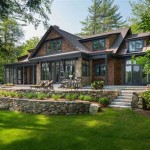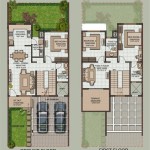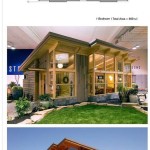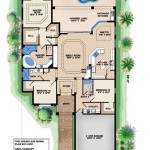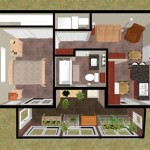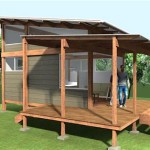Modern Central Courtyard House Plans: A Comprehensive Guide
The central courtyard house, a time-honored architectural design, is experiencing a resurgence in modern architecture. This design strategically incorporates an open, unroofed space, the courtyard, within the confines of a residential structure. The courtyard acts as a focal point, integrating the interior with the exterior while offering numerous benefits, including enhanced natural light, improved ventilation, and a private outdoor oasis.
Modern interpretations of the central courtyard house plans often deviate from traditional layouts, incorporating contemporary materials, minimalist aesthetics, and sustainable building practices. These homes strive to seamlessly blend indoor and outdoor living, maximizing space utilization and creating a harmonious environment.
This guide aims to provide a comprehensive overview of modern central courtyard house plans, exploring their key features, design considerations, advantages and disadvantages, and variations.
Key Features of Modern Central Courtyard House Plans
The defining characteristic of a central courtyard house is, naturally, the courtyard itself. However, several other key features contribute to the overall design and functionality of these modern homes.
The Central Courtyard: This is the nucleus of the design. It can range in size from a compact, intimate space to a sprawling, landscaped area. The size and design of the courtyard are typically dictated by the overall size of the home, the climate, and the homeowner's aesthetic preferences. Courtyards may be enclosed by walls on all sides, creating a fully private sanctuary, or they may be partially open to the surrounding landscape. Often, large glass doors or windows connect the interior spaces to the courtyard, blurring the lines between inside and outside.
Integration of Indoor and Outdoor Spaces: Modern central courtyard house plans prioritize the seamless integration of interior and exterior living. Large sliding glass doors, expansive windows, and strategically placed openings create visual connections between the interior rooms and the courtyard. This design approach promotes natural light penetration, improves cross-ventilation, and encourages residents to spend more time outdoors.
Privacy and Security: The central courtyard design inherently provides a heightened level of privacy and security. The surrounding walls effectively shield the courtyard from the outside world, creating a secluded and intimate space. This is particularly beneficial in densely populated urban areas or locations where privacy is highly valued. The enclosed nature of the courtyard also provides a sense of security, acting as a natural barrier against unwanted intrusions.
Open Floor Plans: Many modern central courtyard house plans incorporate open floor plans in the interior. This design approach allows for better flow of light and air throughout the house and enhances the connection between different living areas. The open floor plan also creates a sense of spaciousness and facilitates social interaction.
Use of Natural Materials: Modern designs frequently incorporate natural materials such as wood, stone, and bamboo to create a warm and inviting atmosphere. These materials complement the natural aesthetic of the courtyard and help to integrate the house with its surroundings. Sustainable building materials are also often prioritized to minimize the environmental impact of the construction.
Design Considerations for Central Courtyard House Plans
Planning a central courtyard house requires careful consideration of various factors to ensure that the design is both functional and aesthetically pleasing. Several variables should be weighed before finalizing house plans.
Climate: The climate of the region is a crucial factor to consider. In hot climates, the courtyard can provide shade and help to cool the house through natural ventilation. In colder climates, the courtyard can be designed to capture sunlight and create a sheltered microclimate. The orientation of the courtyard should be carefully considered to maximize sunlight exposure in winter and minimize it in summer. Plant selection should also be appropriate for the local climate.
Orientation: The orientation of the house is essential for optimizing natural light and ventilation. A south-facing courtyard will receive the most sunlight, which is beneficial in colder climates. An east-facing courtyard will receive morning sun, while a west-facing courtyard will receive afternoon sun. The orientation should be carefully considered based on the local climate and the homeowner's preferences.
Privacy: The level of privacy desired is another important consideration. If privacy is a top priority, the courtyard should be fully enclosed by walls. If a more open feel is desired, the walls can be partially open or replaced with landscaping. Consideration should be given to the privacy of neighboring properties as well.
Size and Shape: The size and shape of the courtyard will depend on the overall size of the house and the homeowner's preferences. A small courtyard can be used as a private retreat, while a larger courtyard can be used for entertaining or gardening. The shape of the courtyard can be rectangular, square, circular, or any other shape that complements the design of the house.
Landscaping: Landscaping is an integral part of the central courtyard design. Plants can be used to create shade, provide privacy, and add visual interest. The selection of plants should be appropriate for the local climate and the desired aesthetic. Water features, such as fountains or ponds, can also be incorporated to create a tranquil and relaxing atmosphere.
Materials: The choice of materials is important for both the aesthetic and the functionality of the house. Natural materials such as wood, stone, and brick can be used to create a warm and inviting atmosphere. Sustainable building materials should be prioritized to minimize the environmental impact of the construction. The materials used in the courtyard should be durable and weather-resistant.
Advantages and Disadvantages of Central Courtyard House Plans
Like any architectural design, central courtyard house plans offer both advantages and disadvantages. Understanding these can help homeowners make informed decisions.
Advantages:
Enhanced Natural Light and Ventilation: The central courtyard allows natural light to penetrate deep into the interior of the house, reducing the need for artificial lighting. The open space also promotes natural ventilation, helping to keep the house cool and comfortable.
Increased Privacy and Security: The enclosed nature of the courtyard provides a heightened level of privacy and security. The surrounding walls effectively shield the courtyard from the outside world, creating a secluded and intimate space.
Improved Indoor-Outdoor Connection: The central courtyard seamlessly connects the interior and exterior spaces, blurring the lines between inside and outside. This design approach encourages residents to spend more time outdoors and enjoy the natural environment.
Aesthetic Appeal: The central courtyard adds a unique and visually appealing element to the house. The open space can be used for landscaping, gardening, or simply relaxing, creating a tranquil and inviting atmosphere.
Reduced Noise Pollution: The courtyard can act as a buffer, reducing noise from the surrounding environment.
Disadvantages:
Higher Construction Costs: Constructing a central courtyard house can be more expensive than building a traditional house. The additional walls and landscaping required for the courtyard can add to the overall cost.
Potential Maintenance: Maintaining the courtyard requires ongoing effort. Landscaping, cleaning, and repairs may be necessary to keep the courtyard in good condition.
Space Requirements: Central courtyard houses typically require a larger footprint than traditional houses. This may not be suitable for properties with limited space.
Climate Considerations: In some climates, the courtyard may not be usable year-round. In colder climates, the courtyard may be too cold to enjoy during the winter months. In hotter climates, the courtyard may be too hot to enjoy during the summer months.
Drainage Issues: Poor drainage in the courtyard can lead to water accumulation and potential damage to the house. Proper drainage systems must be installed to prevent water damage.
Variations in Modern Central Courtyard House Plans
Modern central courtyard house plans are not limited to a single template. They can be adapted and customized to suit different needs and preferences. Several popular variations exist:
Single-Story Courtyard Homes: These homes feature a single level surrounding the central courtyard, creating a seamless flow between indoor and outdoor spaces. They are particularly suitable for individuals with mobility issues or those who prefer a minimalist lifestyle.
Two-Story Courtyard Homes: These homes incorporate two levels, with the courtyard often serving as a focal point visible from both floors. This design provides more living space while still maintaining the benefits of a central courtyard.
L-Shaped Courtyard Homes: In this variation, the house is L-shaped, with the courtyard occupying the inner angle. This design can be particularly effective for maximizing natural light and ventilation.
U-Shaped Courtyard Homes: Similar to the L-shaped design, U-shaped courtyard homes feature a U-shaped building surrounding the courtyard. This design provides a strong sense of enclosure and privacy.
Atrium-Style Courtyard Homes: Atrium-style homes feature a glazed roof over the courtyard, creating an indoor atrium space. This design is suitable for climates where an open courtyard may not be usable year-round.
Small Courtyard Homes: These homes optimize space by incorporating a smaller, more intimate courtyard. These can be achieved through strategically placed light wells or narrow corridors.
Ultimately, the optimal central courtyard house plan will depend on the specific site conditions, the homeowner's lifestyle, and their budgetary constraints. A well-designed central courtyard house can provide a comfortable, private, and aesthetically pleasing living environment.

Mediterranean Style House Plan 4 Beds 3 5 Baths 3163 Sq Ft 72 177 Plans Courtyard Southwest

Five Houses From Courtyard Living Contemporary Of The Asia Pacific

Great Compositions Light And Private Courtyard Houses

Taa Design Develops House In Vietnam Around Central Tree Planted Courtyard

Looklen Architects Builds The Roof House In Thailand Around Central Open Courtyard

The Small Garden Design Ideas

Build A House With Courtyard Blog Dreamhomesource Com

An Expert Guide To Internal Courtyards In Your Home Houzz Au

Days In Yard Studio S Renovated Courtyard Project Beijing

Hiiragi S House Is A Japanese Home Arranged Around Courtyard And Tree
Related Posts

